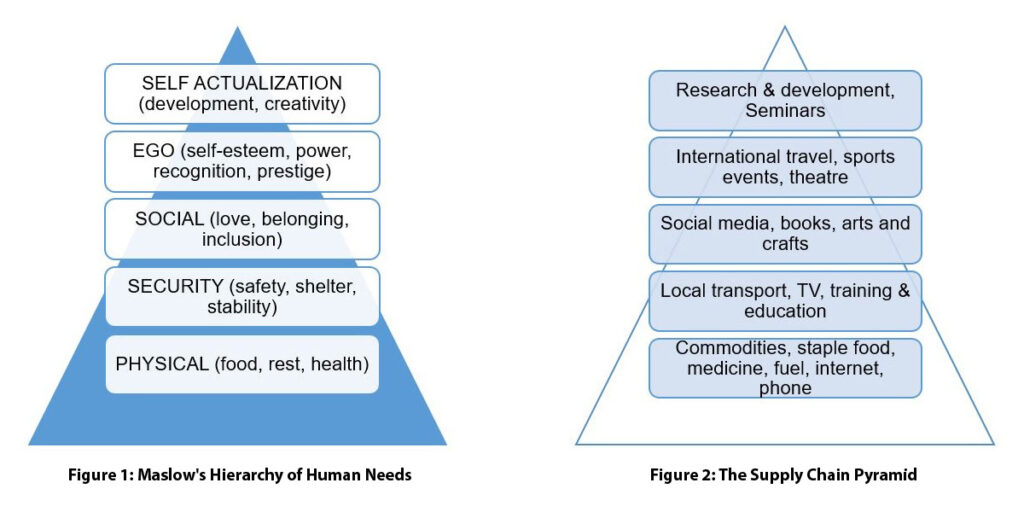How can we understand the relationship between COVID-19 and Supply Chain? Let’s use the example of two pyramid models. The first is the supply chain pyramid and the second is Maslow’s hierarchy of needs pyramid.
In the Supply Chain Pyramid, the largest portion of the pyramid, the base, comprises items of daily necessity. For example, daily diet, medicines, personal products. In this base are related services that we need for our daily function and safety. For example, communication services like internet, telephone, mail, and courier services. The base of the pyramid is the largest and that is symbolic of the fact that these products and services make up the largest amount of products and services out there, and, at lower and medium prices.
However, as we move further up the pyramid, we are looking at selected products such as perfumes, fashion products, and accessible forms of entertainment like books, puzzles, social media, and other non-essential products and services. Their availability is represented by being at the narrower ends of the pyramid meaning that they are available at lower volumes and at higher price brackets. Further up are the luxury items such as travel, sports, entertainment. with low volumes but the highest price brackets. The stratification of the supply chain products can be likened to Abraham Maslow’s hierarchy of human needs, which has the physical and security needs at the bottom, social needs in the middle, and self-actualization at the very top.
The similarities continue. Basic sustenance needs are a higher priority in underdeveloped or developing economies, and higher-level needs are more prevalent in advanced ones. This relates to their respective affordability and opulence levels.
In the same way, demand for higher-priced, luxury items is robust and stable in times of prosperity but stagnates in a slowing economy or in the wake of a natural disaster or a pandemic.
This can be witnessed in the current economic setback caused by COVID-19. Luxuries products and services are totally shut-down, while the items and services of daily and urgent needs such as medicines, hospitals, clinics, groceries, gas stations, and commercial transportation, are operated on a priority basis. Even in healthcare, elective procedures are delayed to make room for critical cases. In business and education, communication takes a different form – online – in order to make the best of available means and minimize the damage.
Related: Role of Cyber Security in Supply Chain Risk Management
The following diagrams of Maslow’s hierarchy of human needs and the supply chain pyramid help explain the relationship:

The two diagrams demonstrate a parallel relationship. The base of the Supply Chain Pyramid is dependable and will remain catering to the base needs of the population. It will stay firms in terms of its demand and in sustainable and high volumes. Technology is a great equalizer of social status since it allows anyone with access to average equipment and connectivity to have access to news, social forums, and entertainment of their choice. During this time of COVID-19, we can see that the basic needs for physical wellbeing are in high demand, as outlined in Maslow’s. This demand is confirmed by the Supply Chain Pyramid and its base points to the commodities that will always be in steady demand as well.
How can we use this parallel relationship? We can use this to streamline our priorities and focus on mainstream products and services. The existing supplier can use this analogy to draw their disaster response plans, in terms of capacity and supply options. Likewise, industries that deal in the same line of products at a different level in the hierarchy can make backup plans to quickly switch their resources to produce and deliver the products belonging to the base of the pyramid. An example is the quick response of many corporations to retool their operations to manufacture the life-saving respirators that are in short supply and in great need.
Indeed, agile corporations with a higher sense of social responsibility make these connections every day. By doing so, they are able to prepare and fulfill the ongoing and emerging needs of their customers and clients worldwide.
Related: COVID-19 – Impact on Global Supply Chains
Contributed by:
Aftab Khan, CISCOM

Aftab Khan is a logistics specialist with over forty years of experience in all aspects of supply chain and logistics management. He is an engineer by training and holds an MBA, besides several certifications from APICS/ASCM, ISCEA, and BRASI. Mr. Khan is the Executive Director of Business Research and Service Institute LLC, USA.
-
Aftab Khan#molongui-disabled-link




